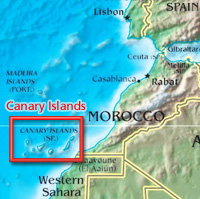Canary Islands & Tenerife
 The Canary Islands consist of seven islands of volcanic origin in the Atlantic Ocean, off the north western coast of Africa. Together, the islands form one of Spain’s seventeen autonomous communities.
The Canary Islands consist of seven islands of volcanic origin in the Atlantic Ocean, off the north western coast of Africa. Together, the islands form one of Spain’s seventeen autonomous communities.
The seven Canary Islands are: Tenerife, La Palma, La Gomera, El Hierro, Gran Canaria, Lanzarote and Fuerteventura.
Tenerife is the largest of the islands. It’s famous as the “Island of Spring,” thanks to its year-round springtime temperatures; and as the home of “El Teide,” Spain’s largest mountain and the third-largest volcano in the world.
Our school is located in Tenerife’s second-largest city, San Cristobal de La Laguna. Known as “La Laguna,” the city was established in 1496 and was the capital of the Canary Islands up until their conquest. It lies in the north of the island and has a population is of 125,000, with 99% of its inhabitants being Spanish-speaking.
 Numerous historical monuments, palaces, churches and traditional houses can be found throughout La Laguna. As the original capital of the Islands, the city holds great historical importance and is graced by a vast cultural heritage. It was designated a UNESCO World Heritage Centre in 1999.
Numerous historical monuments, palaces, churches and traditional houses can be found throughout La Laguna. As the original capital of the Islands, the city holds great historical importance and is graced by a vast cultural heritage. It was designated a UNESCO World Heritage Centre in 1999.
It was in La Laguna where the first University of the Canaries was built, in 1817. Currently, the University has a student population of 30,000 (a figure that’s not included in the city’s population figures).
There are plenty of interesting places to visit in La Laguna, from beautiful natural parks to world-class museums. A few of the most popular sites are the Nava Palace, the “Plaza del Adelantado,” the La Vega Lagunera Park and the Market of La Laguna. If you are thinking about studying Spanish in another area of Spain take a look at the Spanish Courses in Spain Intensive Spanish programs with excellent facilities and activities.
